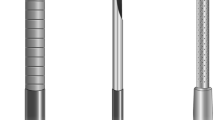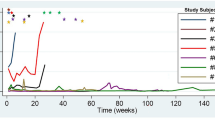Abstract
Endoscopic ultrasound (EUS) has become the most accurate imaging modality for locoregional cancer staging of the gastrointestinal tract. Fine-needle aspiration (FNA) has added a new level of accuracy for EUS in nodal staging, with reported numbers in the 90% range for luminal and pancreaticobiliary disease. In addition, new non-gastrointestinal applications are being evaluated, such as the role of EUS-FNA for the staging of non-small-cell lung cancer and exploration of the posterior mediastinum. Furthermore, the same techniques that make safe tissue sampling possible are being explored for their use as interventional applications, such as EUS-guided celiac plexus neurolysis, fine-needle injection, EUS-guided pseudocyst drainage, and EUS-guided cholangiography and pancreatography. This review describes the current clinical status of EUS in gastrointestinal oncology, as well as future and novel indications and therapeutic strategies for this technology.
This is a preview of subscription content, access via your institution
Access options
Subscribe to this journal
Receive 12 print issues and online access
$209.00 per year
only $17.42 per issue
Buy this article
- Purchase on Springer Link
- Instant access to full article PDF
Prices may be subject to local taxes which are calculated during checkout





Similar content being viewed by others
References
Rosch T (1995) Endosonographic staging of esophageal cancer: a review of literature results. Gastrointest Endosc Clin N Am 5: 537–547
Vazquez-Sequeiros E et al. (2001) Impact of EUS-guided fine-needle aspiration on lymph node staging in patients with esophageal carcinoma. Gastrointest Endosc 53: 751–757
Pfau P et al. (2001) EUS predictors of long-term survival in esophageal carcinoma. Gastrointest Endosc 53: 63–469
Harewood G and Kumar K (2004) Assessment of clinical impact of endoscopic ultrasound on esophageal cancer. J Gastroenterol Hepatol 19: 433–439
Harewood G and Wiersema M. (2002) A cost analysis of endoscopic ultrasound in the evaluation of esophageal cancer. Am J Gastroenterol 97: 452–458
Wallace M et al. (2002) An analysis of multiple staging management strategies for carcinoma of the esophagus: computed tomography, endoscopic ultrasound, positron emission tomography, and thoracoscopy/laparoscopy. Ann Thorac Surg 74: 1026–1032
Wallace M et al. (2000) Dilatation of malignant esophageal stenosis to allow EUS guided fine-needle aspiration: safety and effect on patient management. Gastrointest Endosc 51: 309–313
Zuccaro G et al. (1999) Endoscopic ultrasound cannot determine suitability for esophagectomy after aggressive chemoradiotherapy for esophageal cancer. Am J Gastroenterol 94: 906–912
Scotiniotis I et al. (2001) Accuracy of EUS in the evaluation of Barrett's esophagus and high-grade dysplasia or intramucosal carcinoma. Gastrointest Endosc 54: 689–696
Waxman I et al. (2004) Clinical impact of conventional endoscopy in patients with Barrett's esophagus and high-grade dysplasia or intramucosal carcinoma referred for endoscopic ablation therapy [abstract]. Gastrointest Endosc 59: AB108
Xi W et al. (2003) Endoscopic ultrasonography in preoperative staging of gastric cancer: determination of tumor invasion depth, nodal involvement and surgical resectability. World J Gastroenterol 9: 254–257
Javaid G et al. (2004) Role of endoscopic ultrasonography in preoperative staging of gastric carcinoma. ANZ J Surg 74: 108–111
Roder J et al. (1993) Prognostic factors in gastric carcinoma: results of the German Gastric Carcinoma Study. Cancer 72: 2089–2097
Soetikno R et al. (2003) Endoscopic mucosal resection. Gastrointest Endosc 57: 567–579
Waxman I and Saitoh Y (2000) Clinical outcome of endoscopic mucosal resection for superficial GI lesions and the role of high-frequency US probe sonography in an American population. Gastrointest Endosc 52: 322–327
Chu K et al. (2004) A prospective evaluation of catheter probe EUS for the detection of ascites in patients with gastric carcinoma. Gastrointest Endosc 59: 471–474
Nakamura S et al. (2001) Predictive value of endoscopic ultrasonography for regression of gastric low-grade and high-grade MALT lymphomas after eradication of Helicobacter pylori. Gut 48: 454–460
Pavlick A et al. (1997) Endoscopic ultrasound in the evaluation of gastric small lymphocytic mucosa-associated lymphoid tumors. J Clin Oncol 15: 1761–1766
Savides T and Master S (2002) EUS in rectal cancer. Gastrointest Endosc 56 (Suppl 4): s12–s18
The Swedish Rectal Trial Group (1997) Improved survival with preoperative radiotherapy in resectable rectal cancer. Swedish Rectal Cancer Trial. N Engl J Med 336: 980–987
Camma C et al. (2000) Preoperative radiotherapy for resectable rectal cancer: a meta-analysis. JAMA 284: 1008–1015
Shami VM et al. (2004) The clinical impact of endoscopic ultrasound guided fine needle aspiration in the management of rectal carcinoma. Dis Colon Rectum. 47: 59–65
Harewood G and Wiersema M (2002) Cost-effectiveness of endoscopic ultrasonography in the evaluation of proximal rectal cancer. Am J Gastroenterol 97: 874–882
Franquemont D (1995) Differentiation and risk assessment of gastrointestinal stromal tumors. Am J Clin Pathol 103: 41–47
Hunt GC et al. (2003) A comparison of EUS features between CD-117 positive GI stromal tumors and CD-117 negative GI spindle cell tumors. Gastrointest Endosc 57: 469–474
Chak A (2002) EUS in submucosal tumors. Gastrointest Endosc 56 (Suppl 4): s43–s48
Wallace M et al. (2001) Endoscopic ultrasound-guided fine needle aspiration for staging patients with carcinoma of the lung. Ann Thorac Surg 72: 1861–1867
Fritscher-Ravens A et al. (2003) Mediastinal lymph node involvement in potentially resectable lung cancer: comparison of CT, positron emission tomography, and endoscopic ultrasonography with and without fine-needle aspiration. Chest 123: 442–451
Eloubeidi M et al. (2004) Endoscopic ultrasound-guided fine needle aspiration is superior to fluoro-deoxyglucose positron emission and chest computed tomography in staging mediastinal lymph nodes in patients with suspected non-small cell lung cancer [abstract]. Gastrointest Endosc 59: AB107
Aabakken L et al. (1999) Cost-efficacy of endoscopic ultrasonography with fine-needle aspiration vs. mediastinotomy in patients with lung cancer and suspected mediastinal adenopathy. Endoscopy 31: 707–711
Harewood G et al. (2002) Cost-minimization analysis of alternative diagnostic approaches in a modeled patient with non-small cell lung cancer and subcarinal lymphadenopathy. Mayo Clin Proc 77: 155–164
Wallace M et al. (2003) Detection of telomerase expression in mediastinal lymph nodes of patients with lung cancer. Am J Respir Crit Care Med 167: 1587–1588
Pellise M et al. (2004) Detection of lymph node metastases by gene promoter hypermethylation in samples obtained by endosonography-guided fine-needle aspiration biopsy (EUS-FNA) [abstract]. Gastrointest Endosc 59: AB108
Varadarajulu S et al. EUS-guided FNA of lung masses adjacent to or abutting the esophagus after unrevealing CT-guided biopsy or bronchoscopy. Gastrointest Endosc 60: 293–297
Palazzo L et al. (1993) Endoscopic ultrasonography in the diagnosis and staging of pancreatic adenocarcinoma. Results of a prospective study with comparison to ultrasonography and CT scan. Endoscopy 25: 143–150
Muller M et al. (1994) Pancreatic tumors: evaluation with endoscopic US, CT, and MR imaging. Radiology 190: 745–751
Kochman ML (2002) EUS in pancreatic cancer. Gastrointest Endosc 56 (Suppl 4): s6–s12
Gress F et al. (1999) Role of EUS in the preoperative staging of pancreatic cancer: a large single-center experience. Gastrointest Endosc 50: 786–791
Erickson R and Garza A (2001) EUS with EUS-guided fine-needle aspiration as the first endoscopic test for the evaluation of obstructive jaundice. Gastrointest Endosc 53: 475–484
Burtin P et al. (1997) Diagnostic strategies for extrahepatic cholestasis of indefinite origin: endoscopic ultrasonography or retrograde cholangiography? Results of a prospective study. Endoscopy 29: 349–355
Harewood G and Wiersema M (2001) A cost analysis of endoscopic ultrasound in the evaluation of pancreatic head carcinoma. Am J Gastroenterol 96: 2651–2656
Ahmad N et al. (2003) Interobserver agreement among endosonographers for the diagnosis of neoplastic versus non-neoplastic pancreatic cystic lesions. Gastrointest Endosc 58: 59–64
Brugge W et al. (2004) Cystic neoplasms of the pancreas. N Engl J Med 351: 1218–1226
O'Toole D et al. (2001) Assessment of complications of EUS-guided fine-needle aspiration. Gastrointest Endosc 53: 470–474
Raimondo M and Wallace MB (2004) Diagnosis of early pancreatitis by endoscopic ultrasound. Are we there yet? JOP 5: 1–7
Yalcin S (2004) Diagnosis and management of cholangiocarcinomas: a comprehensive review. Hepatogastroenterology 51: 43–50
Fritscher-Ravens A et al. (2004) EUS-guided fine-needle aspiration of suspected hilar cholangiocarcinoma in potentially operable patients with negative brush cytology. Am J Gastroenterol 99: 45–51
Eloubeidi M et al. (2004) Endoscopic ultrasound-guided fine needle aspiration biopsy of suspected cholangiocarcinoma. Clin Gastroenterol Hepatol 2: 207–208
Fujita N et al. (1999) Diagnosis of the depth of invasion of gallbladder carcinoma by EUS. Gastrointest Endosc 50: 659–663
Amouyal P et al. (1994) Diagnosis of choledocholithiasis by endoscopic ultrasonography. Gastroenterology 106: 1062–1067
Polkowski M et al. (1999) Helical computed tomographic cholangiography versus endosonography for suspected bile duct stones: a prospective blinded study in non-jaundiced patients. Gut 45: 744–749
Loperfido S et al. (1998) Major early complications from diagnostic and therapeutic ERCP: a prospective multicenter study. Gastrointest Endosc 48: 1–10
Masci E et al. (2001) Complications of diagnostic and therapeutic ERCP: a prospective multicenter study. Am J Gastroenterol 96: 417–423
Prat F et al. (1996) Prospective controlled study of endoscopic ultrasonography and endoscopic retrograde cholangiography in patients with suspected common-bile duct lithiasis. Lancet 13: 75–79
Norton S and Alderson D (1997) Prospective comparison of endoscopic ultrasonography and endoscopic retrograde cholangiopancreatography in the detection of bile duct stones. Br J Surg 84: 1366–1369
Dill J et al. (1995) Combined endoscopic ultrasound and stimulated biliary drainage in cholecystitis and microlithiasis–diagnoses and outcomes. Endoscopy 27: 424–427
Dahan P et al. (1996) Prospective evaluation of endoscopic ultrasonography and microscopic examination of duodenal bile in the diagnosis of cholecystolithiasis in 45 patients with normal conventional ultrasonography. Gut 38: 277–281
Levy MJ and Wiersema MJ (2003) EUS-guided celiac plexus block neurolysis and celiac plexus block. Gastrointest Endosc 57: 923–930
Giovannini M et al. (2003) Endoscopic ultrasound-guided cystogastrostomy. Endoscopy. 35: 239–245
Wiersema M et al. (1996) Endosonography-guided cholangiopancreatography. Gastrointest Endosc 43: 102–106
Kahaleh M et al. (2004) Interventional EUS cholangiography: A report of five cases. Gastrointest Endosc 60: 138–142
Mallery S et al. (2004) EUS-guided rendezvous drainage of obstructed biliary and pancreatic ducts: report of 6 cases. Gastrointest Endosc 59: 100–107
Francois E et al. (2002) EUS-guided pancreaticogastrostomy. Gastrointest Endosc 56: 128–133
Kahaleh M et al. (2003) EUS antegrade pancreatography with gastropancreatic duct stent placement: review of two cases. Gastrointest Endosc 58: 919–923
Chang K et al. (2000) Phase I clinical trial of allergenic mixed lymphocyte culture (cytoimplant) delivered by endoscopic ultrasound-guide fine-needle injection in patients with advanced pancreatic carcinoma. Cancer 15: 1325–1335
Bedford R et al. (2000) Tolerability and efficacy of direct injection of pancreatic adenocarcinomas with ONYX-015 under endoscopic ultrasound (EUS) guidance. Gastrointest Endosc 51: AB97
Chang C et al. (2004) A novel transfer therapy against pancreatic cancer (TNFerade) delivered by endoscopic ultrasound (EUS) and percutaneous guided fine needle injection (FNI) [abstract] Gastrointest Endosc 59: AB92
Author information
Authors and Affiliations
Corresponding author
Ethics declarations
Competing interests
The authors declare no competing financial interests.
Glossary
- T STAGING
-
Tumor staging; the degree of local extension of a tumor
- N STAGING
-
Nodal staging; the degree of lymph node involvement of a tumor
- CELIAC LYMPH NODE
-
Lymph nodes located along the celiac trunk that receive lymph from the stomach, spleen, duodenum, liver, and pancreas
- COX PROPORTIONAL HAZARDS
-
A method for assessing a covariate's effect on time to event
Rights and permissions
About this article
Cite this article
Shami, V., Waxman, I. Technology Insight: current status of endoscopic ultrasonography. Nat Rev Gastroenterol Hepatol 2, 38–45 (2005). https://doi.org/10.1038/ncpgasthep0085
Received:
Accepted:
Issue Date:
DOI: https://doi.org/10.1038/ncpgasthep0085



